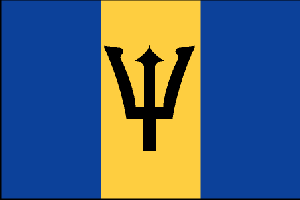
|
Barbados
Background:
The island was uninhabited when first settled by the British in 1627. Slaves
worked the sugar plantations established on the island until 1834 when slavery
was abolished. The economy remained heavily dependent on sugar, rum, and
molasses production through most of the 20th century. The gradual introduction
of social and political reforms in the 1940s and 1950s led to complete
independence from the UK in 1966. In the 1990s, tourism and manufacturing
surpassed the sugar industry in economic importance.
Location:
Caribbean, island between the Caribbean Sea and the North Atlantic Ocean,
northeast of Venezuela
Area: Total: 431 sq km.
Area - comparative: 2.5 times the size of Washington, DC.
Land boundaries: 0 km.
Coastline: 97 km.
Climate and Terrain:
Climate: Tropical; rainy season (June to October).
Terrain: Relatively flat; rises gently to central highland region.
Elevation extremes: Lowest point: Atlantic Ocean 0 m, highest point: Mount
Hillaby 336 m.
Natural resources: Petroleum, fish, natural gas.
People:
Population: 276,607.
Ethnic groups: Black 90%, white 4%, Asian and mixed 6%.
Religions: Protestant 67% (Anglican 40%, Pentecostal 8%, Methodist 7%, other
12%), Roman Catholic 4%, none 17%, other 12%.
Languages: English.
Government:
Government type: Parliamentary democracy; independent sovereign state within
the Commonwealth.
Capital: Bridgetown
Independence: 30 November 1966 (from UK).
Economy overview:
Historically, the Barbadian economy had been dependent on sugarcane
cultivation and related activities, but production in recent years has
diversified into manufacturing and tourism. Offshore finance and information
services are important foreign exchange earners, and there is also a
light-manufacturing sector. The government continues its efforts to reduce
unemployment, encourage direct foreign investment, and privatize remaining
state-owned enterprises. The economy contracted in 2001 due to slowdowns in
tourism and consumer spending. Growth will remain anemic in 2002 with a
recovery likely near the end of the year.
GDP - composition by sector: Agriculture: 6%, industry: 16%., services: 78%.
Statistics:
Telephones - main lines in use: 108,000.
Telephones - mobile cellular: 8,013.
Radio broadcast stations: AM 2, FM 3.
Radios: 237,000.
Television broadcast stations: 1.
Televisions: 76,000.
Internet country code: .bb
Internet users: 6,000.
Railways: 0 km.
Highways: Total: 1,650 km, paved: 1,628 km, unpaved: 22 km.
Airports: 1.
Return to Visiting Locations
|

